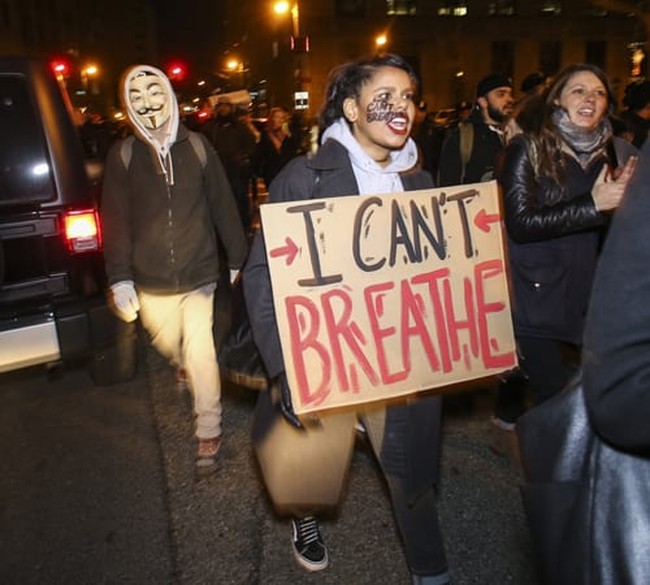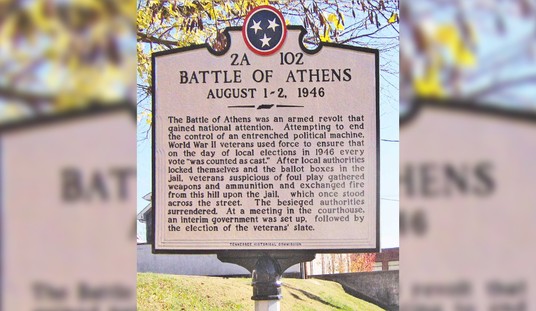
Thousands of demonstrators filled Manhattan streets on the second day of protest against the lack of charges in the death of Eric Garner. (Photo by a katz / Shutterstock.com.)
Gentle readers, repeat after me: “Eric Garner was not choked to death. Eric Garner was not choked to death. Eric Garner was not choked to death.” You may now count yourselves among that small but distinguished minority of Americans who know this to be true.
As I’ve followed the aftermath of Mr. Garner’s death, I’ve been struck by the ignorance displayed by so many ordinarily sensible people offering commentary on the matter. I use the term “ignorance” not as an insult but rather in the benign sense that they are simply uninformed on the facts of the case. Charles Krauthammer, for example, called the Staten Island grand jury’s decision not to indict the NYPD officer implicated in Garner’s death as “totally inexplicable.” George Will took things a qualified adjective further when he labeled the decision as “inexplicable and probably inexcusable.” And Berkeley law professor and former U.S. deputy attorney general John Yoo, discussing the incident on a recent Ricochet podcast (relevant portion at about 57:00), revealed himself as no more informed on the issue than the two columnists. “Looking at the video of what happened,” said Mr. Yoo, “I don’t see any reason why force was required there. With the guy selling loose cigarettes, I don’t see the need to use deadly force to restrain him.”
I have nothing but admiration for Dr. Krauthammer and Messrs. Will and Yoo, but I don’t think I’m going too far out on a limb here in speculating that none of these men, for all their accomplishments, has ever had the experience of trying to arrest a 350-lb. man who has made it clear he does not wish to be arrested. I have, and I offer here a few lessons gleaned from that experience.
I joined the Los Angeles Police Department at a time when officers routinely applied chokeholds to combative suspects. Properly performed, a chokehold was an efficient, and when compared to techniques that replaced it, humane way to end a physical altercation. The guy got froggy (as the expression went), he got choked out, and he woke up in handcuffs, most often none the worse for wear and with his attitude much improved.
On very rare occasions, however, they did not wake up, which led to the LAPD’s ban of the practice except in cases where an officer’s life is in danger. Many other police departments, including New York City’s, have instituted similar policies. But then came the law of unintended consequences: With this force option no longer available, altercations became more violent and more prolonged, and they resulted in more injuries to suspects as officers were trained to incapacitate them with batons rather than subdue them quickly with a chokehold. If offered a choice, most suspects would have preferred momentary unconsciousness to having their limbs smashed with a metal baton.
When enough arms and legs were broken and enough lawsuits were filed as a result, there then came the search for other means to bring a resisting individual under control: Tasers, pepper spray, non-lethal projectiles, and the like, all of which can be effective in some situations but not without the risk of serious injury or even death in others.
And through it all, despite advances in police technology and tactics, by far the most commonly used method to subdue a resisting individual is what you saw in the video of the Eric Garner incident: If time allows, assemble enough cops to surround a suspect so that each cop can grab an arm or a leg or whichever body part that presents itself, wrestle the guy face down on the ground, and then get the handcuffs on him. It happens every day in any city you can name, and I would hazard a guess that the Garner takedown was far from the most violent arrest that took place in New York City that week or even that day.
In examining the Eric Garner incident there are two fundamental questions to be asked: Was there probable cause to arrest him? And if so, was the force used to effect that arrest reasonable? As to the probable cause, Mr. Garner had been caught selling “loosies,” i.e., cigarettes that had not been taxed by New York authorities. Cops have a barnyard expression for such arrests, which is commonly shortened for decorum’s sake to its initials, C.S. But C.S. or not, the law against such sales is on the books and the NYPD is expected to enforce it. Furthermore, the police had received complaints about Mr. Garner’s illicit commerce from local merchants, men and women who are forced to collect taxes on the cigarettes they sell, thus putting them at a competitive disadvantage to Mr. Garner’s more laissez-faire approach to business. (Thanks to the high taxes, New York City has the most expensive cigarettes in the country.)
But alas for Mr. Garner, had the fatal confrontation not come over cigarettes, it very likely would have come over something else, for he was not a man disposed toward honest toil. “Hold on there, Dunphy,” you say. “What about De mortuis nil nisi bonum, and all that?” But it is not I who has described Mr. Garner as being less than industrious, but his own wife. Appearing beside Al Sharpton on the Dec. 7 Meet the Press, Esaw Garner told Chuck Todd that her husband “had issues, you know? Heavy guy. And he was very lazy, you know? He didn’t like to do anything. He wasn’t used to it.” (Video is here; transcript is here.)
What he was used to is being arrested, which he had experienced some 30 times dating back to 1980, including previous arrests for selling untaxed cigarettes. Why he found it more objectionable to be brought in on July 17 than he had in any of his previous arrests is a question that will remain unanswered, but on that day he was caught in the wrong and he knew the drill. The police were going to have him answer for the charge in court, and no amount of sidewalk protestations was going to prevent that from happening. When the police have made the decision you are going to jail, you are going to jail. The only question then remaining is whether you will be taken there directly or with an intervening stop at a hospital. The choice is yours to make.
So, with the question of probable cause settled, we turn now to whether the force used by the officers was reasonable. Contrary to John Yoo’s assertion quoted above, “reasonable force” is not determined by the severity of the crime for which officers are seeking to arrest a person but rather by the level of resistance he offers. It is unclear from the video how long the two plainclothes officers spoke to Mr. Garner prior to moving in for the arrest, but it seems apparent it was long enough for other officers to respond to a request for assistance. It is true that, up to a point, Mr. Garner had offered only verbal objection to being arrested, but when the additional officers arrived on scene it became clear to him that the time for talk had ended. As noted above, he had been arrested many times and knew what to expect. The officers made the simple and routine gesture of trying to grab his arms, but Mr. Garner was having none of it.
Until someone invents and produces a device that will levitate a 350-lb. man to jail without touching him, officers will be left with few options in situations like the one those cops faced that day on Staten Island. When talking has failed, it’s time to go hands-on. We all know how it turned out, so let’s examine what other force options might have been available to the officers. They might have used pepper spray, but even a man who’s been blinded by pepper spray still has to be wrestled into handcuffs, a task that’s often made more difficult by the residual effects the spray can have on the officers themselves. And pepper spray can impair breathing even in a healthy man. What effect might it have had on Mr. Garner, who was obese and suffered from asthma and heart trouble?
Or perhaps the result might have been different had the officers used a Taser, a device that shoots two barbed darts into a person’s skin and delivers 50,000 volts of electricity, resulting in momentarily incapacitating muscle contractions. Given Mr. Garner’s medical condition, wouldn’t the risk to his heart from such a shock have been just as great as that from the method actually employed?
And what about that chokehold? Yes, the video shows that Officer Daniel Pantaleo had his arm around Garner’s neck, but it is far from clear that he was “choking” him as the term is commonly understood. Which brings us to a point that must be made clear if one is to form an educated opinion about what happened to Mr. Garner. There are two types of chokeholds, one that restricts breathing by compressing the trachea, and one that restricts circulation of blood to the brain by compressing the carotid arteries on either side of the neck. (For a more thorough explanation of these techniques from a pair of martial arts instructors, see this YouTube video.) From what I can see in the video, Officer Pantaleo’s arm was not correctly positioned to cut off circulation in Mr. Garner’s carotid arteries. If instead he was crushing the man’s trachea, how is it that the autopsy showed no sign of injury to Mr. Garner’s neck?
I was trained in both of these techniques in the police academy, and I had both performed on me many times during that training as we recruits paired off and took turns choking each other. I can say without question that the method that restricts breathing is by far the more painful and terrifying of the two, and it presents the greater risk of injury. Either technique can render a person unconscious and, if applied for too long, cause death, but Eric Garner was still alive and conscious after Pantaleo was no longer touching his neck. Had Mr. Garner been choked to death, or even into momentary unconsciousness, he would not have been able to speak those now famous words, “I can’t breathe.”
It’s also important to note that, as most any police officer will tell you, everyone who has been manhandled to the ground as Garner was complains that he can’t breathe. It’s when someone stops saying it that officers need to guard against the risk of positional asphyxia by moving him into a position that allows for unimpaired breathing. If this was not done, or was not done quickly enough, it would be a lapse exposing the NYPD to a claim of civil liability, but it would not mean that the force used to subdue Garner was excessive or unwarranted.
So, as in the case of Michael Brown in Ferguson, Missouri, Eric Garner’s death is not really about police tactics or the need for officers to attend “sensitivity training.” It is rather about politics, specifically the politics of race, which demands that we turn a blind eye to the reasons police officers so often come into violent confrontations with black men. I can do no better in explaining these reasons than my friend Heather Mac Donald did in May 2010. Writing about crime in New York City for City Journal, the Manhattan Institute’s quarterly, Ms. Mac Donald reported that:
blacks committed 66 percent of all violent crimes in the first half of 2009 (though they were only 55 percent of all stops and only 23 percent of the city’s population). Blacks committed 80 percent of all shootings in the first half of 2009. Together, blacks and Hispanics committed 98 percent of all shootings. Blacks committed nearly 70 percent of all robberies. Whites, by contrast, committed 5 percent of all violent crimes in the first half of 2009, though they are 35 percent of the city’s population (and were 10 percent of all stops). They committed 1.8 percent of all shootings and less than 5 percent of all robberies. The face of violent crime in New York, in other words, like in every other large American city, is almost exclusively black and brown. Any given violent crime is 13 times more likely to be committed by a black than by a white perpetrator.
These are inconvenient facts for the racial grievance industry, which has been enjoying a bullish trend these past few months. Equally inconvenient is the fact that about 6,000 blacks are murdered each year in the United States, 93 percent of whom are killed by other blacks. Meanwhile, the number of blacks killed by police averages less than 100 per year. Even if you accepted the absurd proposition that not a single one of these police killings is justified, you are still left with a mountain-vs.-molehill comparison. And yet we have rallies and marches and endless hand-wringing commentary lamenting the latter fact while the former is all but ignored. Black lives matter, we are told, but apparently only those that are taken by the police.
And we have people who should know better, like Philadelphia mayor Michael Nutter, suggesting the police are as big a part of the problem as the criminals. Appearing on the same Meet the Press program as Eric Garner’s wife, Mayor Nutter addressed the Eric Garner and Michael Brown deaths. “What are the joining factors [in these cases]?” he asked:
“Two large black men are dead as a result of engagement with the police. And so we have to look at what else is going on with the officers? What are they thinking about? What are some of their fears? What are community fears? I mean, you, in essence, have the citizens who want to be protected who are now increasingly afraid of the police, and you have some police officers who are increasingly afraid of the community.”
To the extent that some police officers are indeed afraid of “the community,” might it have something to do with the statistics in the above passage from Heather Mac Donald? If we “have to look at what else is going on with the officers,” as Mayor Nutter suggests, can we also look at what else is going on with Eric Garner and Michael Brown? No, we cannot, at least according to Al Sharpton. Chuck Todd asked Mr. Sharpton to respond to a statement from Patrick Lynch, president of the New York Patrolmen’s Benevolent Association, which was that Eric Garner had made the decision to resist arrest.
“First of all,” said Mr. Sharpton, “to blame the victim, the insensitivity of that is striking:”
“But it’s also, when you look at the video, the difference between Ferguson and Staten Island, even though we’re bringing them together for now, is the video. And if you see in the video a man taken down on the ground with police over him, and then you continue to choke him, and the chokehold is illegal, are you now saying at the worst-case scenario, if he had resisted arrest and clearly he did, but the penalty then is that you choke him to death? I mean, I think it’s the most absurd premise that this person could have raised.”
It’s not really absurd at all, Mr. Sharpton. What is absurd is that a loathsome, anti-Semitic, tax-cheating fraud is given a platform on what once was a serious and important television program.
Yes, the deaths of Eric Garner and Michael Brown are unfortunate and worthy of discussion, but will Chuck Todd and the rest of the chattering classes spare a moment to address the deaths of Scott Patrick, Joseph Dunn, Michael Pimentel, Geniel Amaro-Fantauzzi, Daryl Pierson, Nickolaus Schultz, Jason Harwood, Joseph Matuskovic, Bryon Dickson, Michael Norris, Joe Naylor, Danny Oliver, Michael Davis, Eugene Kostiuchenko, Jesse Valdez, Shaun Diamond, David Payne, Robert White, Matthew Chism, Justin Winebrenner, Christopher Smith, and Edwin Roman-Acevedo?
Who are these men, you ask, and what happened to them? They are the 22 American police officers murdered just since the day Eric Garner died. There were 33 others killed earlier in the year. Don’t look for any of their widows to appear on Meet the Press.










Join the conversation as a VIP Member